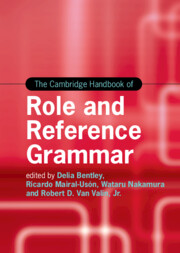Book contents
- The Cambridge Handbook of Role and Reference Grammar
- Cambridge Handbooks in Language and Linguistics
- The Cambridge Handbook of Role and Reference Grammar
- Copyright page
- Dedication
- Contents
- Figures
- Tables
- Contributors
- Pedagogical Guide to The Cambridge Handbook of Role and Reference Grammar
- Introduction
- Part One Overview
- Part Two Topics in RRG: Simple Sentences
- Part Three Topics in RRG: Complex Sentences
- Part Four Applications of RRG
- Part Five Grammatical Sketches
- 22 A Grammatical Sketch of Cheyenne (Plains Algonquian, USA)
- 23 A Grammatical Sketch of Yimas (Lower Sepik, Papua New Guinea)
- 24 A Grammatical Sketch of Avatime (Kwa, Niger-Congo, Ghana)
- 25 A Grammatical Sketch of Amele (Papuan, Papua New Guinea)
- 26 Case and Voice in Amis (Austronesian, Taiwan)
- Index
- References
25 - A Grammatical Sketch of Amele (Papuan, Papua New Guinea)
from Part Five - Grammatical Sketches
Published online by Cambridge University Press: 08 June 2023
- The Cambridge Handbook of Role and Reference Grammar
- Cambridge Handbooks in Language and Linguistics
- The Cambridge Handbook of Role and Reference Grammar
- Copyright page
- Dedication
- Contents
- Figures
- Tables
- Contributors
- Pedagogical Guide to The Cambridge Handbook of Role and Reference Grammar
- Introduction
- Part One Overview
- Part Two Topics in RRG: Simple Sentences
- Part Three Topics in RRG: Complex Sentences
- Part Four Applications of RRG
- Part Five Grammatical Sketches
- 22 A Grammatical Sketch of Cheyenne (Plains Algonquian, USA)
- 23 A Grammatical Sketch of Yimas (Lower Sepik, Papua New Guinea)
- 24 A Grammatical Sketch of Avatime (Kwa, Niger-Congo, Ghana)
- 25 A Grammatical Sketch of Amele (Papuan, Papua New Guinea)
- 26 Case and Voice in Amis (Austronesian, Taiwan)
- Index
- References
Summary
This chapter describes the basic syntax of the Amele (Papuan) language from a Role and Reference Grammar (RRG) perspective. Typologically, Amele has head-last syntax and is head-marking. Nominative-accusative agreement is suffixed to the verb stem and up to four arguments can be marked on the verb. There are only two major lexical categories, nouns and verbs, with very little overlap between these categories. Alternative undergoer selection may be made for ditransitive verbs. There is no passive construction in the language and the only choice for privileged syntactic argument (PSA) is [S, AT]. Focus may be expressed morphologically and by incorporation of modifier elements into the verb word. The language-specific topics featured are serial verb constructions and switch-reference (SR). SR applies to clauses in both coordinate and (some) embedded constructions. It is judged to be a local syntactic device for monitoring the referentiality of PSA arguments between adjacent clauses as to whether they have identical or non-identical reference.
- Type
- Chapter
- Information
- The Cambridge Handbook of Role and Reference Grammar , pp. 914 - 953Publisher: Cambridge University PressPrint publication year: 2023



